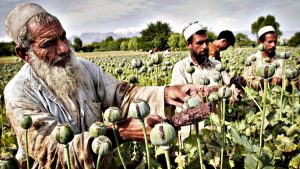

While some may think of the poppy flower as a nice addition to a bouquet or just a pretty flower, it is not only that. The poppy is a flower, a crop, a drug, and a socio environmental factor that connects climate change and conflict in Afghanistan. The rise of opium and the associated epidemic is all too familiar in Afghanistan, illustrating how conflict and human activity are environmental and intertwined in ecological patterns. Within Afghanistan, the majority of the world’s opium is produced and because of the damaging results of this, the Afghan government is attempting to eradicate poppy plants all together, which they have so far been unsuccessful at.
But why are poppy plants such a big deal? The estimated value of poppy is a nearly 3-billion-dollar industry and plays a role in key social structure and environmental dynamics. The climate in Afghanistan is extremely dry and desert like, therefor the agriculture business is heavily dependent on good irrigation. Unfortunately, irrigation is failing within Afghan agriculture, forcing farmers to find different crops that will survive in the dry climate. The poppy is able to thrive in a dry climate so the focus has been shifted to producing those crops. This environmental crisis has led to many farmers growing poppy, even though they know it is illegal and allows for state repression. This shift of farmers towards illegal activity then leads them to engaging with illegal armed actors.
This leads to a chain reaction that is very difficult to stop. The farmers are forced into this illegal situation because they are doing what they need to do to survive and make money, but this is feeding into the armed actors that are using the opium for drug trafficking. Unfortunately, this beautiful flower is causing an immense amount of destruction but the government is having an extremely difficult time grabbing hold of the problem and moving towards a solution.
